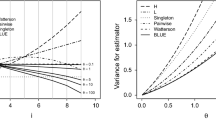Abstract
This paper continues our earlier investigations into the inversion of random functions in a general (abstract) setting. In Section 2, we investigate a concept of invertibility and the invertibility of the composition of random functions defined on finite sets. In Section 3, we resolve some questions concerning the number of samples required to ensure the accuracy of maximum likelihood estimation (MLE) in the presence of ‘nuisance’ parameters. A direct application to phylogeny reconstruction is given.
Similar content being viewed by others
References
Allman E.S., Ané C., Rhodes J.A.: Identifiability of a Markovian model of molecular evolution with gamma-distributed rates. Adv. in Appl. Probab. 40, 229–249 (2008)
Casella G., Berger R.L.: Statistical Inference. Duxbury Press, Belmont (1990)
Chang J.T.: Full reconstruction of Markov models on evolutionary trees: identifiability and consistency. Math. Biosci. 137, 51–73 (1996)
Cover T.M., Thomas J.A.: Elements of Information Theory. John Wiley & Sons, Inc., New York (1991)
Erdös P.L., Steel M.A., Székely L.A., Warnow T.: A few logs suffice to build (almost) all trees (Part 1). Random Structures Algorithms 14, 153–184 (1999)
Everitt B.S.: The Cambridge Dictionary of Statistics. Cambridge University Press, Cambridge UK (1998)
Farris J.S.: Likelihood and inconsistency. Cladistics 15, 199–204 (1999)
Felsenstein J.: Inferring Phylogenies. Sinauer Associates, Inc., Sunderland, MA (2004)
Rogers J.S.: On the consistency of maximum likelihood estimation of phylogenetic trees from nucleotide sequences. Syst. Biol. 46, 354–357 (1997)
Rogers J.S.: Maximum likelihood estimation of phylogenetic trees is consistent when substitution rates vary according to the invariable sites plus gamma distribution. Syst. Biol. 50, 713–722 (2001)
Schrijver A.: Theory of Linear and Integer Programming. John Wiley & Sons Ltd., Chichester (1986)
Semple C., Steel M.: Phylogenetics. Oxford University Press, Oxford (2003)
Siddall M.E.: Success of parsimony in the four-taxon case: long-branch repulsion by likelihood in the Farris zone. Cladistics 14, 209–220 (1998)
Steel M.A., Székely L.A.: Inverting random functions. Ann. Combin. 3, 103–113 (1999)
Steel M.A., Székely L.A.: Inverting random functions II: explicit bounds for the discrete maximum likelihood estimation, with applications. SIAM J. Discrete Math. 15, 562–575 (2002)
Steel M.A., Székely L.A.: Teasing apart two trees. Combin. Probab. Comput. 16, 903–922 (2007)
Wald A.: Note on the consistency of the maximum likelihood estimate. Ann. Math. Statist. 20, 595–601 (1949)
Yang Z.: Statistical properties of the maximum likelihood method of phylogenetic estimation and comparison with distance matrix methods. Syst. Biol. 43, 329–342 (1994)
Yang Z.: Phylogenetic analysis using parsimony and likelihood methods. J. Mol. Evol. 42, 294–307 (1996)
Author information
Authors and Affiliations
Corresponding author
Additional information
We thank the NZIMA Maclaurin Fellowship, the Phylogeny programme at the Isaac Newton Institute of Cambridge University, and Hungarian Bioinformatics MTKD-CT-2006-042794 for supporting this research. The second author was also supported in part by NSF DMS contracts 007 2187, 070 1111, and NIH NIGMS 1 R01 GM078991-01.
Rights and permissions
About this article
Cite this article
Steel, M.A., Székely, L.A. Inverting Random Functions III: Discrete MLE Revisited. Ann. Comb. 13, 365–382 (2009). https://doi.org/10.1007/s00026-009-0023-z
Received:
Published:
Issue Date:
DOI: https://doi.org/10.1007/s00026-009-0023-z




